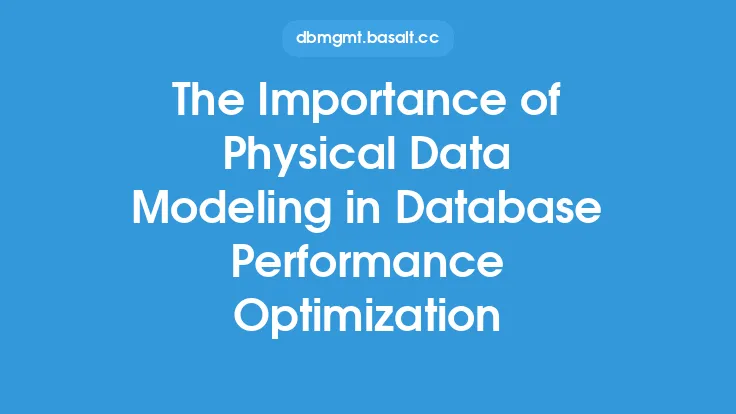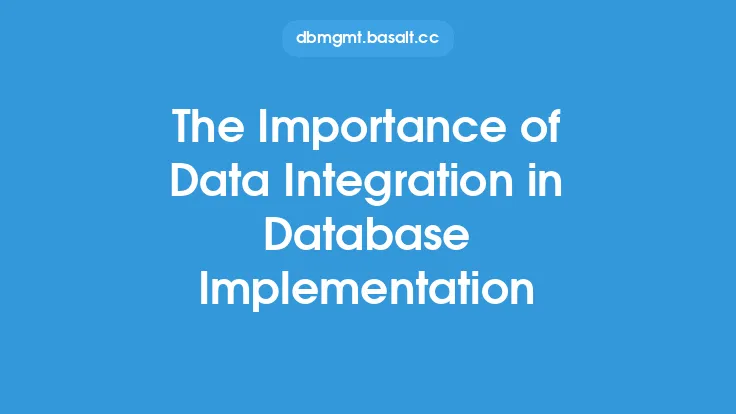Data archiving is a crucial aspect of storage optimization, playing a significant role in maintaining the health and performance of databases. As databases continue to grow in size and complexity, the need for effective data archiving strategies becomes increasingly important. In this article, we will delve into the importance of data archiving in storage optimization, exploring its benefits, best practices, and technical considerations.
Introduction to Data Archiving
Data archiving refers to the process of moving inactive or infrequently accessed data from primary storage to secondary storage, such as tape or disk arrays. This process helps to reduce the amount of data stored on primary storage, thereby improving database performance, reducing storage costs, and enhancing data management. Data archiving is not the same as data backup, although the two are often confused. While data backup involves creating copies of data for disaster recovery purposes, data archiving involves the systematic removal of inactive data from primary storage.
Benefits of Data Archiving
The benefits of data archiving are numerous and significant. By removing inactive data from primary storage, databases can experience improved performance, as the amount of data that needs to be processed and queried is reduced. This, in turn, can lead to faster query execution times, improved data retrieval speeds, and enhanced overall system responsiveness. Additionally, data archiving can help reduce storage costs, as less data needs to be stored on primary storage. This can be particularly beneficial for organizations with large databases, where storage costs can be substantial. Data archiving can also help improve data management, by providing a systematic and automated way of removing inactive data from primary storage.
Best Practices for Data Archiving
To implement effective data archiving strategies, several best practices should be followed. First, it is essential to develop a clear understanding of the data that needs to be archived. This involves identifying inactive or infrequently accessed data, as well as data that is no longer required for business operations. Next, a data archiving policy should be established, outlining the criteria for data archiving, the frequency of archiving, and the storage media to be used. It is also important to ensure that archived data is properly indexed and cataloged, to facilitate easy retrieval and access. Finally, data archiving should be automated, using specialized software or tools to streamline the process and minimize manual intervention.
Technical Considerations for Data Archiving
From a technical perspective, data archiving involves several key considerations. First, the choice of storage media is critical, with options including tape, disk arrays, and cloud storage. Each of these options has its own advantages and disadvantages, and the choice of storage media will depend on factors such as data volume, access requirements, and budget. Next, data archiving software or tools should be selected, to automate and streamline the archiving process. These tools should provide features such as data compression, encryption, and indexing, to ensure that archived data is properly protected and easily accessible. Finally, data archiving should be integrated with existing data management processes, such as data backup and disaster recovery, to ensure a comprehensive and cohesive data management strategy.
Data Archiving and Database Performance
Data archiving can have a significant impact on database performance, particularly in terms of query execution times and data retrieval speeds. By removing inactive data from primary storage, databases can experience improved performance, as the amount of data that needs to be processed and queried is reduced. This, in turn, can lead to faster query execution times, improved data retrieval speeds, and enhanced overall system responsiveness. Additionally, data archiving can help reduce the load on database servers, by minimizing the amount of data that needs to be processed and queried. This can help improve database availability, reduce downtime, and enhance overall system reliability.
Data Archiving and Storage Costs
Data archiving can also have a significant impact on storage costs, particularly for organizations with large databases. By removing inactive data from primary storage, organizations can reduce the amount of data that needs to be stored on expensive primary storage media. This, in turn, can lead to significant cost savings, as less data needs to be stored on primary storage. Additionally, data archiving can help extend the life of existing storage infrastructure, by reducing the amount of data that needs to be stored on primary storage. This can help delay the need for expensive storage upgrades, and reduce the overall cost of storage ownership.
Conclusion
In conclusion, data archiving is a critical aspect of storage optimization, playing a significant role in maintaining the health and performance of databases. By removing inactive or infrequently accessed data from primary storage, databases can experience improved performance, reduced storage costs, and enhanced data management. To implement effective data archiving strategies, it is essential to develop a clear understanding of the data that needs to be archived, establish a data archiving policy, and automate the archiving process using specialized software or tools. By following best practices and considering technical factors such as storage media and data archiving software, organizations can ensure that their data archiving strategies are effective, efficient, and aligned with their overall data management goals.





